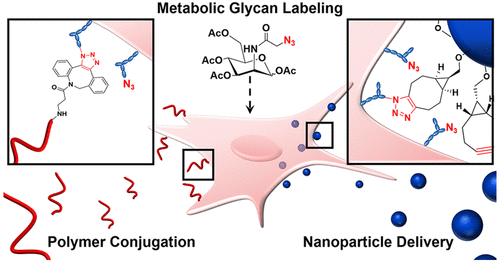Gibson Group News
Viewpoint article on engineering cell surfaces published in ACS Macroletters
 Engineering cell surfaces is not trivial. In Nature gene regulation controls protein expression, but we are interested in non-genetic tools to introduce new functionality to cell surfaces, specifically synthetic polymers. In this viewpoint we summarize how the technique of metabolic glycan labeling is being used in polymer/nanoscience to introduce non-natural functionality to cell surfaces. Metabolic glycan labeling allows the introduction of bio-orthogonal handles (e.g. azides) to cells by hijacking glycan biosynthesis pathways by addition of e.g. Azido-N-acetyl mannosamine derivatives, which is processed into sialic acid on the cell surface. This azide (or other functionality) can be used to recruit polymers to the cell surface by formation of a covalent bond. In this article we highlight this really exciting area of biomaterials and summarises some applications including cell-tracking, studying cell-cell communication and more.
Engineering cell surfaces is not trivial. In Nature gene regulation controls protein expression, but we are interested in non-genetic tools to introduce new functionality to cell surfaces, specifically synthetic polymers. In this viewpoint we summarize how the technique of metabolic glycan labeling is being used in polymer/nanoscience to introduce non-natural functionality to cell surfaces. Metabolic glycan labeling allows the introduction of bio-orthogonal handles (e.g. azides) to cells by hijacking glycan biosynthesis pathways by addition of e.g. Azido-N-acetyl mannosamine derivatives, which is processed into sialic acid on the cell surface. This azide (or other functionality) can be used to recruit polymers to the cell surface by formation of a covalent bond. In this article we highlight this really exciting area of biomaterials and summarises some applications including cell-tracking, studying cell-cell communication and more.
This article is part of the 100th Anniversary of Macromolecular Science series.
